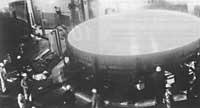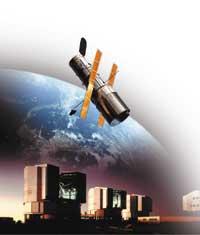Green light
2003/04/09 Kortabarria Olabarria, Beñardo - Elhuyar Zientzia

Although the ALMA project is called a radio telescope, it is not a system made up of 64 radio telescopes. Each of them will have a diameter of 12 meters and will be able to work together. It is a project promoted by the European countries, the United States and Canada that make up the ESO.
64 antennas will be located in the Chilean desert of Atacama, in the place known as Chajnantor. They will work together as a single telescope, although everyone will receive their own information. They will receive information about millimeter wavelengths and below millimeter of spectrum. This radiation crosses the border between infrared and waves and is one of the keys to understanding the formation of planets and stars. In turn, to understand the formation of the first galaxies, galactic clusters and organic molecules it is necessary to have the information of these wavelengths.
Because the steam is capable of absorbing millimeter and lower millimeter waves, the ALMA system will be located in a drier area of 5,000 meters. Thus, steam interference has been sought to be the least possible.

New opportunities are expected for astrophysicists For example, they believe that they will be able to know what the first galaxies of the universe were like. The capacity of the 64 radio telescopes is enormous, much greater than the current one.
It seems that a prototype will be underway for next year. In case of no delays, the ALMA system will be complete by 2007 and will therefore be able to start testing. If deadlines are met, ALMA will start working fully in 2011. Meanwhile, the VLT set of telescopes will be the largest and most powerful in the world.
VLT the most powerful so far
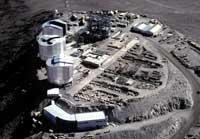
The Very Large Telescope, or VLT, of ESO's European organization, is the leading representative of the new generation of telescopes. It is based on new materials and new technological knowledge and is extremely powerful. VLT is the world's largest and most advanced optical telescope. It is not a telescope, but a group. They can work individually or together. Working together, the set would be equivalent to a 16-metre diameter telescope.
Each of the giant mirrors is only 18 centimeters thick. They are flexible, so they require a computer-guided support system. The main core of VLT consists of four 8.2-metre diameter telescopes each. Each telescope consists of several foci in which the weak light of the celestial skylights is collected through different complementary instruments. However, the system's most spectacular way of working will be achieved when the light from all telescopes is coherently combined. Then, working all telescopes together, VLT will be a giant interferometer.
There are also additional 1.8 metre mobile telescopes mounted on rails. Improves overall performance. This observation mode, known as interferometric VLT, will provide sharper images than current ones. Imagine if there were an astronaut on the Moon, VLT would see it.

But if this enormous capacity will give good results it is necessary to solve a basic problem. As the light of a star passes through the Earth's atmosphere, it is influenced by atmospheric turbulence. Therefore, in our eyes, the light of the stars flashes. Also in the plane of the telescope focus the image of the star moves, which significantly degrades the quality of the image of the resulting star after prolonged exposure.
But this problem has a solution. ESO and some French research centres, working together, have prepared a new tool, a new technique, to correct in real time the distortion of light.
The area of the tool is a flexible mirror. Interspersed in the path of light, before the detector. Its shape can change very quickly, so the light is continuously resentful and corrects the distortion caused by atmospheric turbulence. Consequently, the image of the star looks much clearer, as the movement that had previously disappeared. The telescope works as if it were in space, that is, without atmospheric distortions.
The main mirrors of the VLT are monolithic, made with one piece. Never before the VLT had such a large mirror been made. The German company Mainz Schott has developed a new manufacturing technique.
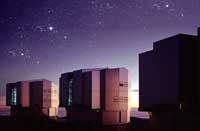
They left the mold to make a giant mirror. The mold was painted with 45 tons of molten glass at 1,400 degrees Celsius. By spinning the mold in the first cooling phase, the glass adopts a slightly concave shape. In the next steps of production, glass became Cerodur, the glass ceramic, whose thermal expansion coefficient is zero, which is very important to ensure the optical quality of VLT.
Each step of the procedure required rigorous quality control. The giant mirror discs were polished by the French company REOSC. The accuracy of the mirror surface was checked by interferometers.
In 1995, after two years at REOSC, ESO engineers began conducting detailed testing of the first of the four main mirrors. Careful measurements showed that the optical surface was adequate and that the error was 5 millimeters one hundred thousand. This means that on an area of 165 kilometers in diameter, as in the distance between Tudela and Baiona, there would be only one millimeter of error. It takes almost four years to make a mirror.

The accuracy of the other components is also at this level: the structure in which the mirror is located is a combination of electromechanical, hydraulic and electronic systems and telescope tools. The main mechanical structure is also spectacular, weighs 430 tons
The entire structure rests on a thin layer of floating oil. The motors and other drive mechanisms are also highly accurate, moving the telescope with great precision. Building a VLT telescope for engineers has been a great challenge. They have had to precisely combine large and heavy structures. The assembly was attended by numerous high-level companies from all over Europe.
In order to verify compliance with the technical specifications and their proper functioning, the first giant telescope was tested before being moved to its real location at the Anbalance factory in Milan, the VLT observatory in Chile.
Clear desert

In the Atacama desert the climate is very special. Apparently it is not a very pleasant place, but it is one of the most appropriate places to place an astronomical observatory. In the west, on the Chilean coast, the cold current of Humboldt circulates; in the east, the immense mountain chain Andes. Both create a kind of barrier that prevents the passage of clouds. Consequently, the territory between the two is extremely dry, with a clear sky 350 days a year.
If we travel by plane along the Pacific coast, the aerial view clearly shows the difference between the wet coast and the desert. ESO specialists analyzed the region for ten years in search of the best place to locate VLT. Finally, ESO chose a 2,664 metre mountain: Cerro Paranal. It is 12 kilometers from the Pacific and about 130 kilometers south of the city of Antofagasta.
To begin with, 350.000 cubic meters of stones were removed from the top of the mountain and had to be eaten 28 meters at the height of the mountain to build a large platform to place telescopes. Workers and specialists from various professions worked intensively for several years before scientists for the first time put the new supertelcope to heaven.
In December 1997 a ship approached the port of Antofagasta. Inside there was a mirror of 8.2 meters, the first for VLT. Gradually they left the boat and placed it in a special vehicle. From then on he had to make a long journey through a dirt road before arriving at Cerro Paranal.

The trip began the next morning. The convoy with mirror moved to 6 kilometers per hour. On the abrupt road they had to reduce the speed to 3 kilometers per hour. It took three days to reach its location.
Measuring and looking in detail proved that the valuable and fragile mirror arrived in good condition. Four months later, in April 1998, in the mirror maintenance building, they mounted the mirror in its basic structure. The basis of the mirror was the masterpiece of technology: a sophisticated system of computer-controlled active media. It weighed only 10 tons and, in addition to maintaining the accessories, supported the 22 tons of the main mirror so that its shape was always perfect. After placing the mirror and its base on the telescope, they had to align the optical system.
VLT tooling
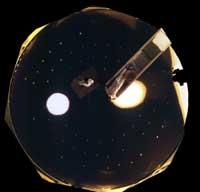
These tools are very complex. Each of them consists of more than 20,000 pieces. The VLT is equipped with a multitude of tools. The first of the four large telescopes began working with two tools: Force and Isaac are truly responsible for the work of VLT. Both tools include complex cameras and spectrographs to analyze the near and distant universe beyond current borders. They analyze visible wavelengths and infrared waves.
The VLT had to overcome very demanding tests in order to start regular scientific work in 1998. But although it was still in the test phase, with the new telescope astronomers got many spectacular images. Observations with the Force camera showed the spiral galaxy NGC 1232: It has a diameter of 200,000 light years, double that our galaxy, the Milky Way. It is 100 million light years from us. Despite the enormous distance, the excellent optical quality of VLT and Force allowed to see many details.
The beautiful spiral galaxy NGC 1288 was also discovered with VLT. Formes is located in the southern set of stars, 300 million light years from us.
Closer to the earth, at 1,200 light-years, another image taken with the Force camera showed the details of the Tambell nebula. The Tambel star fog is made up of a raked gas. Gas has been expelled from the central star, which is in the last steps of its evolution. The strong ultraviolet radiation of the star warms the atoms of the gas and makes them shine with spectacular colors.
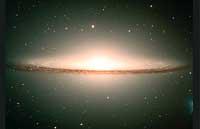
From the far corners of space, the limit of the universe we can see, to the hidden places where stars and planets in our galaxy are emerging, VLT offers scientists new perspectives.
He has always wanted to know what is beyond the horizon. VLT will help get out of darkness and look at the unknown. We are at the gates of a new era of discovery.
Published in D2 section of Deia.

Gai honi buruzko eduki gehiago
Elhuyarrek garatutako teknologia





